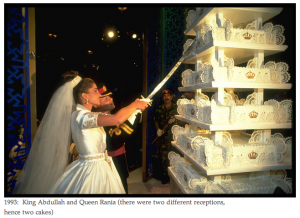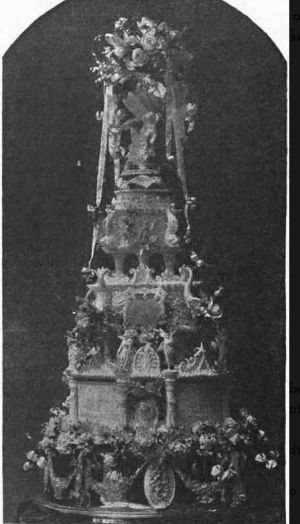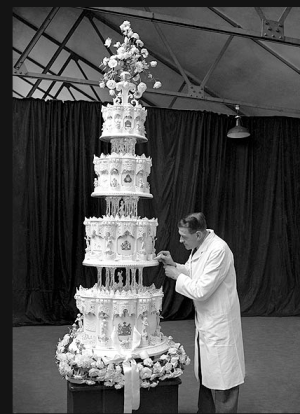The History of Wedding Cakes
THE HISTORY OF WEDDING CAKES The earliest recipe recorded from Britain for a dish for a wedding was in fact a fruit pie. These were piled on top of one another to create a pyramid centerpiece. Queen Victoria was the first queen to use the wedding cake as a focal point at her wedding reception and it was Queen Victoria we can thank for the bridal tradition of wearing white. Before her marriage to Prince Albert on February 11th 1840, the traditional royal wedding dress was silver. Her white wedding dress, trimmed with white honiton lace was a first for the fashion world, so was her matching white, very elaborate wedding cake.

Her cake was adorned with cupids, signifying love and dogs, signifying faithful attraction. This masterpiece weighed 300 lbs., was 9' in circumference and was 7' high. At that time, there was no refrigeration, so to preserve cakes in order to accommodate the weeks of elaborate art work in sugar adorning the cake, fruit was saturated in alcohol, whisky, brandy or sherry, (or a little of each) baked. After the cake was baked, the alcohol mix was then brushed repeatedly over the surface of the cake to preserve it and to flavor it. Fruitcakes, like fine wines, mature with age so a long shelf life was recommended.
Probably one of the most ostentatious wedding cakes of the Victorian era was that of Queen Victoria's daughter Princess Louise, on her marriage to the Marquis of Lorne in 1871. The Royal Family of the time was opposed to the marriage, but Queen Victoria approved and the couple married in lavish style. The wedding cake stood 5 feet tall from its base to the top tier and weighed over 225 pounds and, of course, it was finished in fine white royal icing. The first genuinely public Royal marriage ceremony was that of Princess Elizabeth (Queen Elizabeth II) to the Duke of Edinburgh. This was the first televised Royal wedding and the first ever occasion that television cameras had been allowed to film from inside Westminster Abbey.
Following the marriage and the day's events guests were invited to an opulent supper. The Royal couple had a total of nine wedding cakes at their reception, with the official cake standing 9 feet tall and weighing in at a staggering 500 pounds. Their official cake had four tiers, three of them replicating in sugar Buckingham Palace, Windsor Castle and Balmoral Castle.
Fruitcake is still the traditional cake of preference in England, Canada, Australia and Southern Africa. Traditionally the frosting used to elaborately adorn these fruitcakes was named royal Icing, made from powdered sugar and egg whites. (In 1840 the sugar was laboriously and finely ground using a pestle and mortar.) Royal icing dries extremely hard to support the layers place on top of each other. Columns separating the cakes were disguised pieces of broom handle covered in royal Icing to match the cake icing covering the cake. Because the royal icing was so hard, a decorative silver hammer placed on the cake table and was used to break the royal icing, which was peeled from the cake before the cake could be cut. Some 100 years later a new ingredient invention called glycerin was introduced into royal icing. which rendered it softer and prevented the royal icing from becoming hard and brittle. The traditional silver hammer was then replaced with a long serrated cake knife or a royal sword was used to make the traditional and symbolic first cut into the cake.

In the 1960’s, an Australian baker created a mixture of powdered sugar, glycerin, liquid glucose, gelatin and a small amount of vegetable fat. This mixture was dough like in appearance and texture and could be rolled out like pastry. This immediately took cake decorating by a storm and became the new fashionable frosting, for covering cakes. Known today as plastic icing (Australian name) sugar paste (English name) and rolled fondant, (American name). The new dough was rolled out and placed over the cake completely enrobing it, and therefore, alleviating the need for covering a cake in royal icing. This new product quickly spread to England and its colonies, and today, is the most popular method of decorating special occasion and celebration cakes.

Rolled fondant was introduced to the American market approximately 30 years ago. However, it has only become popular over the last decade with exposure from cake challenges on the television networks. The nature and texture of rolled fondant has opened the doors to much creativity and artistry. Today wedding cakes are both traditional and contemporary and are often seen not only in the traditional white and ivory, but also contemporary in style. Wedding cake are now displayed in a multitude of colors, shapes and sizes, with an eclectic array of edible bows, flowers, drapes, polka dots and stripes, swirls and curly-cues and designs to fit any theme imaginable.
Posted on 12/07/2017 at 12:00 AM
